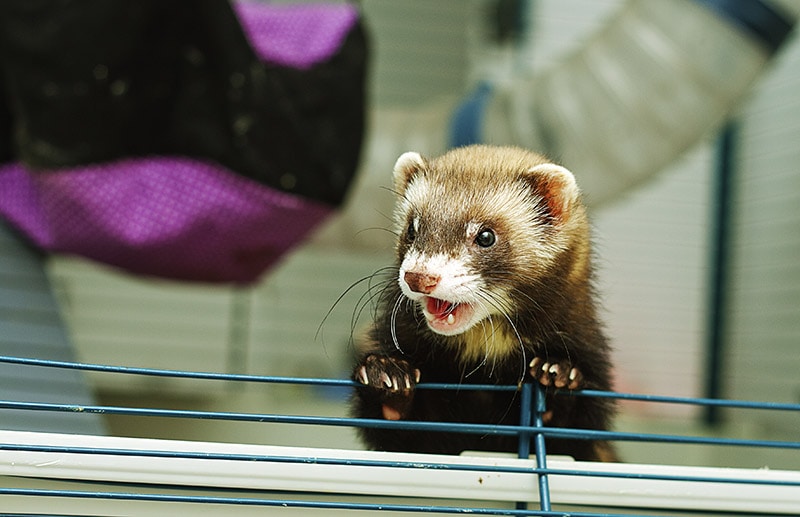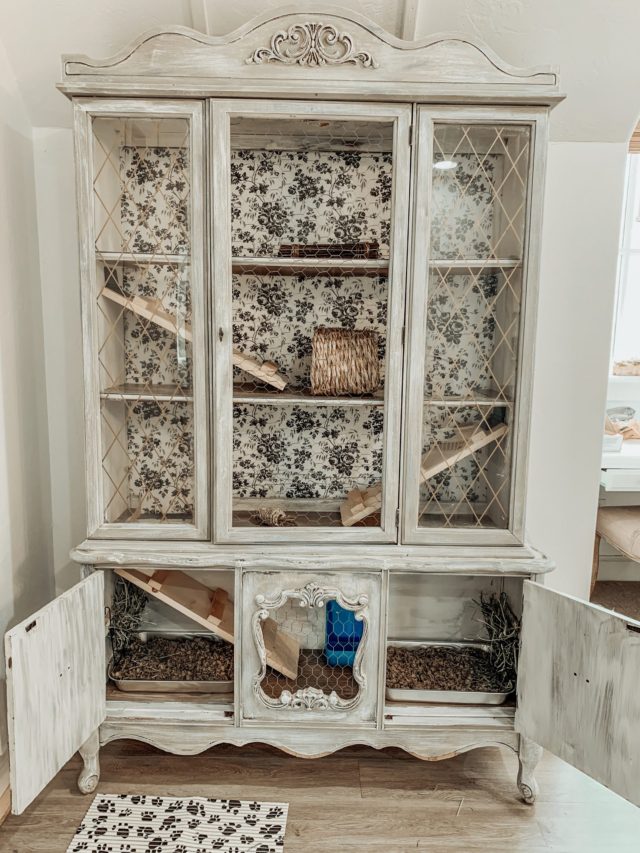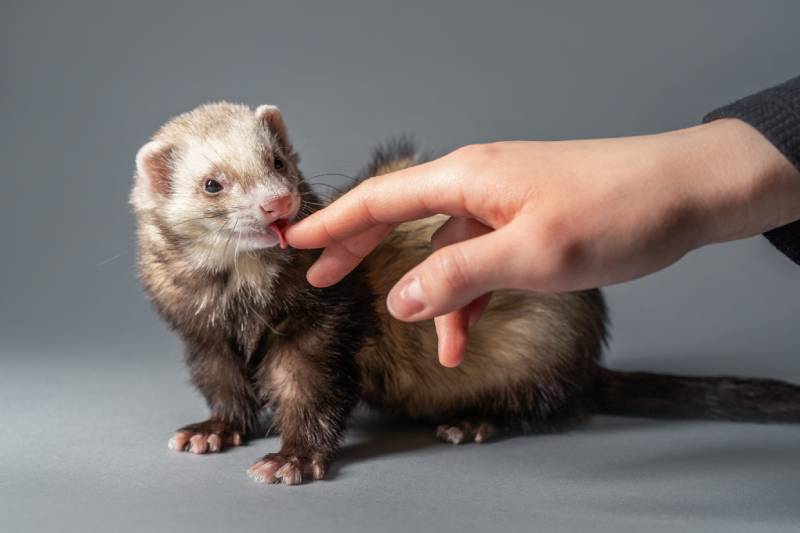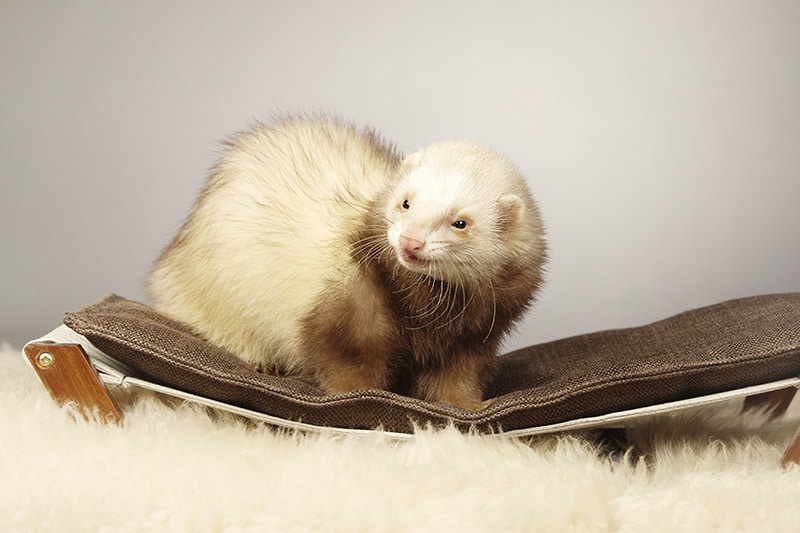3 DIY Ferret Cage Plans You Can Build Today (with Pictures)

Updated on

Every ferret owner needs a cage, but some cages can just be unsightly and expensive. So why not DIY one? A ferret cage is a great way to provide a safe and comfortable environment for your pet. Luckily, they’re quite straightforward to build.
While a ferret cage may seem basic, there are actually many ways that you can put one together. In this article, we’ll take a look at some of the best plans out there. You may need some skills working with tools, but all of these cages can be built in a weekend, or maybe even a day.

The 3 DIY Ferret Cages
1. Rabbit Hutch Perfect for a Ferret by Simply Summer Morgan

| Materials: | Ikea cupboard or sideboard, Waterproof flooring material, Drill, Sawzall, Wire mesh, Wire cutters, Staple gun |
This plan is perfect for those who don’t want to spend too much time building a cage. With just a few hours of work using basic tools, you can create a hutch that not only has plenty of ventilation holes but also features a strong and sturdy design. This ensures the utmost comfort and safety for your furry friends while adding an attractive aesthetic to your space. So, whether you’re a beginner or an experienced DIY enthusiast, this plan offers a convenient and rewarding solution for housing your pets.
2. PVC Pipe Ferret Cage by SugarGlider

| Materials: | PVC pipes, Pipe fittings, Netting, Zip ties or staple gun, Plywood (optional for sturdier base), Bolts/washers/nuts, Hook and eye latch |
This plan is absolutely perfect for those who want to unleash their creativity and design a truly personalized ferret cage. It’s designed for sugar gliders but can easily be used to house ferrets as well. With just a few basic tools and a minimal time investment of just a few hours, you can create a customized haven for your furry friend.
The finished product of this DIY project offers ample space for your pet to roam and explore, ensuring their comfort and happiness. Additionally, the design provides excellent ventilation to maintain a healthy living environment for your beloved ferret. So go ahead and embark on this exciting adventure of crafting a one-of-a-kind ferret cage that your pet will absolutely adore!
3. Fancy Entertainment Center Upcycle Cage by The Rabbit House

| Materials: | Old Entertainment Center/Furniture Piece, Wallpaper (optional), Wire Mesh, Wire cutters, Jigsaw, Staple gun |
This plan provides a creative and unique way to repurpose an old entertainment center or furniture piece into a cozy home for your ferret. The spacious shelves of the entertainment center will be used as various levels for your ferret to explore, climb, and play. Additionally, you can use any remaining space to store food and bedding items. By using wire mesh and a staple gun to secure the structure so your ferret can’t escape, you can provide a safe and stimulating habitat for your furry friend to enjoy. With some creative repurposing and a bit of elbow grease, you can easily upcycle an old entertainment center into a ferret cage.
Why Build Your Own Ferret Cage?
Building your own ferret cage has several advantages. Firstly, it allows you to create a unique space that caters to your ferret’s preferences. Whether your pet loves to climb or burrow, you can incorporate these elements into your design. Secondly, DIY cages can often be more cost-effective than store-bought ones. With some basic materials and tools, you can build a spacious and functional cage. Lastly, the process of building a cage can be a fun and rewarding project for pet owners.
The Basics of Building a Ferret Cage
Before you start constructing your ferret cage, it’s important to understand the basics. A good ferret cage should have ample space for your pet to move around, separate areas for sleeping and playing, and easy access for cleaning and feeding. The cage should also be well-ventilated and secure to prevent your ferret from escaping. It’s also recommended to use non-toxic and durable materials to ensure your pet’s safety and the cage’s longevity.
Additional Tools You Might Need for Building a Ferret Cage
The essential tools for building a ferret cage include measuring tape, a drill, pliers, wire cutters, and a screwdriver. A staple gun may also be useful for attaching mesh to the wooden frame. Additionally, you’ll need sandpaper to smooth out any rough edges and a paintbrush if you decide to paint or varnish the cage. Remember to use paints and varnishes that are non-toxic and safe for pets.

Safety Considerations When Building a Ferret Cage
Safety should be a top priority when building a ferret cage. Ensure all doors and openings are secure to prevent escapes. Avoid using materials with sharp edges or small parts that could be swallowed. Also, ensure the cage is sturdy and stable to withstand your ferret’s active behavior. Regularly inspect the cage for any potential hazards and promptly address any issues.
Adding Extra Features to Your Ferret Cage
Adding extra features to your ferret cage can enhance your pet’s comfort and enjoyment. Some ideas include hammocks for lounging, ramps, and ladders for climbing, and hideouts for sleeping or relaxing. You should also add a litter box and food and water dishes. Remember to regularly update the toys and enrichment items in the cage to keep your ferret entertained and stimulated.
Maintaining and Cleaning Your DIY Ferret Cage
Regular maintenance and cleaning are essential to keep your DIY ferret cage in good condition. Clean the cage at least once a week by removing and washing all bedding, toys, and dishes. Wipe down the walls and floors with a pet-safe disinfectant. Regularly check the cage for any damage or wear and repair or replace parts as necessary. This will help ensure your ferret’s home remains clean, safe, and enjoyable.

Conclusion
Building your own ferret cage can be a rewarding project that results in a unique and comfortable home for your pet. By following this guide, you can create a cage that meets your ferret’s needs and fits your living space. Remember to prioritize safety, comfort, and entertainment in your design. With a bit of effort and creativity, you can provide your ferret with a fantastic living environment they will love to explore and play in.
Featured Image Credit: Best dog photo, Shutterstock










